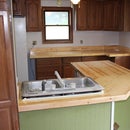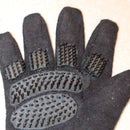Introduction: Indestructible Speaker Instructable
So, to resolve my problem I built a pair of battery powered, waterproof and totally self contained speakers. By self contained, I mean that the batteries, amp, and MP3 player are all housed inside the waterproof speakers. Even if these were washed overboard they would continue to play as they floated away on their own journey down the river, and sound great doing it. (But I hope this never happens)
These are an easy build, very cheap, and totally worth the time put in. They are small enough and light enough to keep in a backpack or daypack so you can have music during a hike. I've added suction cups on the back so they can be mounted to a car window for car camping. Basically, I think they are great for any outdoor activity.
I haven't been rafting yet since I finished them, but when I do I will post a video of them on the river.
Step 1: Supplies and Tools
The supplies and tools needed for this build are few.
Starting with supplies:
- 2 empty CD containers (the kind that blank CD's come in)
- a set of cheap computer speakers
- 2 sandwich or zip-lock bags
- Battery leads (found at Radio Shack, very inexpensive)
- electrical tape
- clear box tape (packing tape)
And the tools
- aquarium glue or silicone sealant (found at any hardware store, DAP makes some which is what I found at Homedepot)
- a drill and small drill bits
- utility knife
- screw driver
- electrical tape
- clear box tape (packing tape)
- scissors
- possisibly a rotory tool (dremel) with a cut off disc
Step 2: Speaker Di-section
I bought a pair of Altec Lansing computer type speakers a while ago from Walmart for around $10. They sound OK but soon I decided to upgrade, so I had this pair just lying around. If you need a set to do this build I recommend an inexpensive set, preferably a set that can already be powered by batteries. Most of these will have an onboard volume control.
Ok, the first thing we want to do is remove the speakers from their original housing. This is usually pretty simple. When it comes to the speaker wire, cut it about 3-4 inches from the speaker, this should allow you to extract the speaker completely. As I said though, this is all very simple stuff.
Cut the power cord as well, about 3-4 inches from the speaker.
I was fortunate that the on/off switch and volume control were mounted on a small font plate that was a seperate piece from the rest of the speaker housing. Depending on how your speaker was built, you may need to use you dremel to cut around the volume knob and power knob to seperate it from the speaker. Try to keep your cut-out as small as possible so that it fits inside your new speaker.
Step 3: Remount the Speakers
Having removed the speakers from the original housings, we can start to build our own housings. Use one of the speakers to trace its outline on the tops of both containers with your sharpy. Now use your utility knife to cut out a circle for the speaker to rest in.
When they fit well, use your aquarium glue and glue them into place. Make sure to seal the speaker hole completely so water cannot get inside.
Step 4: Extra Layer of Water Protection
After the speakers are mounted and the glue is dry, we're going to add another layer of protection.
Take your scissors and cut your sandwich or ziplock bag into halves.
(NOTE: I used a sandwich bag because they are thinner, and I was afraid something thicker would muffle the sound too much. After completing my speakers and testing them, I would recommend using the ziplock bag. The layer of plastic infront of the speaker does not muffle the sound at all, so a thicker baggie will give your speakers better protection.)
Spread a thin layer of aquarium glue around the outer edge of the top of the CD container, and then place one half of a baggie over top. Press the baggie into the glue to make a water-tight seal. Now slightly pull outward on the edges of the baggie to tighten it up. When the glue is dry, trim the excess plastic off.
Step 5:
For the actual speaker covers, I used some old car speaker grills and cut them to fit. You can use the covers that came with your computer speakers, and cut them to fit. Another option is a thick piece of cloth or thin carpeting. You could even cut a piece of thin wood to fit, drill several holes in it, making a nice looking wooden grill. What you use will depend on availability and your intended use.
For use in water, I suggest something like stained wood, painted metal or plastic. You don't want your speaker cover collecting a lot of water.
Secure these tightly to the front with small screws. Make sure to seal the screw holes with a little more aquarium glue.
Step 6: Battery Leads
My speakers came with a transformer plug (I think that's what you would call it), And they run on 9 volts of power. I bought a package of 9 volt battery leads from Radio Shack, and connected two of them to the power wire. I used two of them to give me a descent lifespan on the batteries. I could have used all five that came in the package, but there is not enough room for all those batteries in the speaker. Connecting all those leads is possible by connecting them in parallel. This means that all of the positive wires are connected to each other, and all of the negative wires are connected together.
If your speakers run on an odd voltage, like 6 volts, there is no 6 volt battery. Therefore you will need to achieve the necessary voltage useing AA batteries. Each AA puts out 1.5 volts, so you will need four of them to get 6 volts
4 batteries X 1.5 volts = 6 volts So you would buy a battery lead that holds 4 AA
Again, connect positive to positive, and negative to negative. Simple as that. Use wire nuts or tape all connections with electrical tape.
Step 7: Seal Up the Wire Holes
The speaker wires will be run through the post hole in the bottom of the CD containers. I also ran the mini-jack that plugs into the MP3 player, to the second speaker. Once the wires are run and connected to each speaker, we need to seal the post holes with some aquarium glue.
As you can see, I also added some suction cups as well. Obviously these are totally optional.
Step 8: Access Doors
You will need to cut some access doors so you can turn it on and off, and select music without opening the whole container. These openings can then be sealed up with box tape.
Step 9: Wrap It All Up
All that's really left to do is to wrap up the wires that run between the speakers with electrical tape, so they don't flap around loose.
We'll also seal the speakers tops to their bottoms. Although it seems ridiculous, cheap, and isn't very attractive, box tape does a great job of sealing the containers together.
Remember these are not submarines, they are just meant to protect your electronics from the splashes of rapids or from the rain so you can enjoy them wherever you go.

Participated in the
Hack It! Contest

Participated in the
3rd Annual Make It Stick Contest

Participated in the
DIY Audio













